
Meliaceae, the mahogany family, is a flowering plant family of mostly trees and shrubs in the order Sapindales.

Amorphophallus is a large genus of some 200 tropical and subtropical tuberous herbaceous plants from the Arum family (Araceae), native to Asia, Africa, Australia and various oceanic islands. A few species are edible as "famine foods" after careful preparation to remove irritating chemicals. The genus includes the Titan arum of Indonesia, which has the largest inflorescence of any plant in the genus, and is also known as the 'corpse flower' for the pungent odour it produces during its flowering period, which can take up through seven years of growth before it occurs.

The Anacardiaceae, commonly known as the cashew family or sumac family, are a family of flowering plants, including about 83 genera with about 860 known species. Members of the Anacardiaceae bear fruits that are drupes and in some cases produce urushiol, an irritant. The Anacardiaceae include numerous genera, several of which are economically important, notably cashew, mango, Chinese lacquer tree, yellow mombin, Peruvian pepper, poison ivy, poison oak, sumac, smoke tree, marula and cuachalalate. The genus Pistacia is now included, but was previously placed in its own family, the Pistaciaceae.

Celtis is a genus of about 60–70 species of deciduous trees, commonly known as hackberries or nettle trees, widespread in warm temperate regions of the Northern Hemisphere. The genus is part of the extended Cannabis family (Cannabaceae).
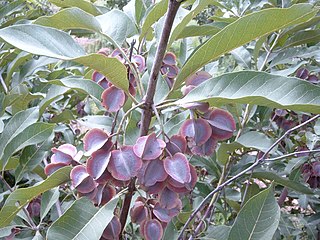
Combretum, the bushwillows or combretums, make up the type genus of the family Combretaceae. The genus comprises about 272 species of trees and shrubs, most of which are native to tropical and southern Africa, about 5 to Madagascar, but there are others that are native to tropical Asia, New Guinea and the Bismarck Archipelago, Australia, and tropical America. Though somewhat reminiscent of willows (Salix) in their habitus, they are not particularly close relatives of these.

Canarium is a genus of about 120 species of tropical and subtropical trees, in the family Burseraceae. They grow naturally across tropical Africa, south and southeast Asia, Indochina, Malesia, Australia and western Pacific Islands; including from southern Nigeria east to Madagascar, Mauritius, Sri Lanka and India; from Burma, Malaysia and Thailand through the Malay Peninsula and Vietnam to south China, Taiwan and the Philippines; through Borneo, Indonesia, Timor and New Guinea, through to the Solomon Islands, Vanuatu, New Caledonia, Fiji, Samoa, Tonga and Palau.
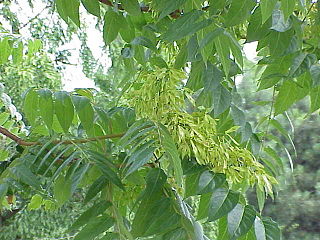
The Simaroubaceae are a small, mostly tropical, family in the order Sapindales. In recent decades, it has been subject to much taxonomic debate, with several small families being split off. A molecular phylogeny of the family was published in 2007, greatly clarifying relationships within the family. Together with chemical characteristics such as the occurrence of petroselinic acid in Picrasma, in contrast to other members of the family such as Ailanthus, this indicates the existence of a subgroup in the family with Picrasma, Holacantha, and Castela.
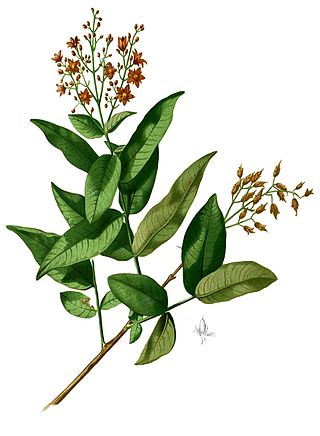
Cratoxylum is a genus of flowering plants in the family Hypericaceae, native to tropical Asia. The generic name means "strong wood", referring to the timber.

Dysoxylum is a genus of rainforest trees and shrubs in the flowering plant family Meliaceae. About 34 species are recognised in the genus, distributed from India and southern China, through southeast Asia to New Guinea, Solomon Islands, and Australia. The name Dysoxylum derives from the Greek word ‘Dys’ meaning "bad" referring to "ill-smelling" and ‘Xylon’ meaning "wood".

The genus of the myrrhs, Commiphora, is the most species-rich genus of flowering plants in the frankincense and myrrh family, Burseraceae. The genus contains approximately 190 species of shrubs and trees, which are distributed throughout the (sub-) tropical regions of Africa, the western Indian Ocean islands, the Arabian Peninsula, India, and South America. The genus is drought-tolerant and common throughout the xerophytic scrub, seasonally dry tropical forests, and woodlands of these regions.
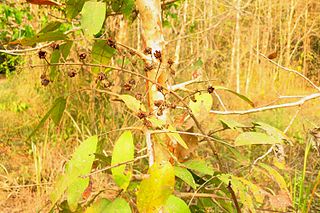
Cratoxylum cochinchinense is a plant now placed in the family Hypericaceae. The specific epithet cochinchinense is from the Latin meaning "of Cochinchina". In Vietnamese C. cochinchinense is usually called thành ngạch nam or lành ngạnh nam, other names include: hoàng ngưu mộc, hoàng ngưu trà and đỏ ngọn.

Anacolosa is a plant genus of 15 to 22 species. In the APG IV system, the genus is placed in the family Olacaceae. Other sources place it in the segregate family Aptandraceae. The generic name is from the Greek anakolos, meaning "knotted", referring to the calyx cup rim.

Beilschmiedia is a genus of trees and shrubs in family Lauraceae. Most of its species grow in tropical climates, but a few of them are native to temperate regions, and they are widespread in tropical Asia, Africa, Madagascar, Australia, New Zealand, North America, Central America, the Caribbean, and South America. The best-known species to gardeners in temperate areas are B. berteroana and B. miersii because of their frost tolerance. Seeds of B. bancroftii were used as a source of food by Australian Aborigines. Timbers of some species are very valuable.
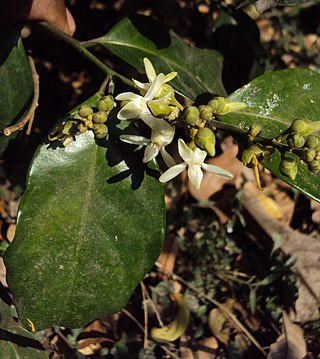
Xanthophyllum is a genus of about 109 species of trees and shrubs, of the plant family Polygalaceae;. The generic name is from the Greek meaning "yellow leaf", referring to how the leaves are often yellow when dry. In Borneo it is known as minyak berok in Malay or nyalin in the Iban language.

Antiaris toxicaria is a tree in the mulberry and fig family, Moraceae. It is the only species currently recognized in the genus Antiaris. The genus Antiaris was at one time considered to consist of several species, but is now regarded as just one variable species which can be further divided into five subspecies. One significant difference within the species is that the size of the fruit decreases as one travels from Africa to Polynesia. Antiaris has a remarkably wide distribution in tropical regions, occurring in Australia, tropical Asia, tropical Africa, Indonesia, the Philippines, Tonga, and various other tropical islands. Its seeds are spread by various birds and bats, and it is not clear how many of the populations are essentially invasive. The species is of interest as a source of wood, bark cloth, and pharmacological or toxic substances.
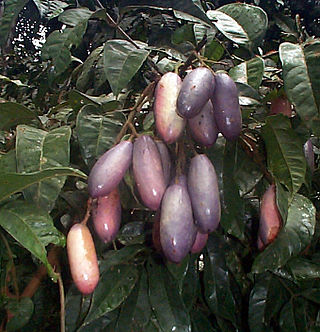
Dacryodes is a genus of about 60 species of trees in the family Burseraceae. The generic name is from the Greek dakruon meaning "tear(drop)", referring to how resin droplets form on the bark surface.

Trema orientale is a species of flowering tree in the hemp family, Cannabaceae. It is known by many common names, including charcoal-tree, Indian charcoal-tree, pigeon wood, Oriental trema, and in Hawaii, where it has become naturalized, gunpowder tree, or nalita. It has a near universal distribution in tropical and warm temperate parts of the Old World, with a range extending from South Africa, through the Middle East, the Indian subcontinent and southern China to Southeast Asia and Australia.
Didymocheton mollissimus is a species of tree in the family Meliaceae. It ranges from eastern India and Bangladesh to southern China, Myanmar, Thailand, Peninsular Malaysia, Borneo, Sumatra, Java, the Lesser Sunda Islands, and the Philippines, where it grows in lowland tropical moist forests.

Strombosia ceylanica is a tree in the family Olacaceae. The specific epithet ceylanica is from the Latin meaning "of Ceylon".
Strombosia scheffleri is a medium-sized tree that is native to Tropical Africa, the species is sometimes planted as a shade tree in coffee and cocoa plantations. It belongs to the family Olacaceae.

















